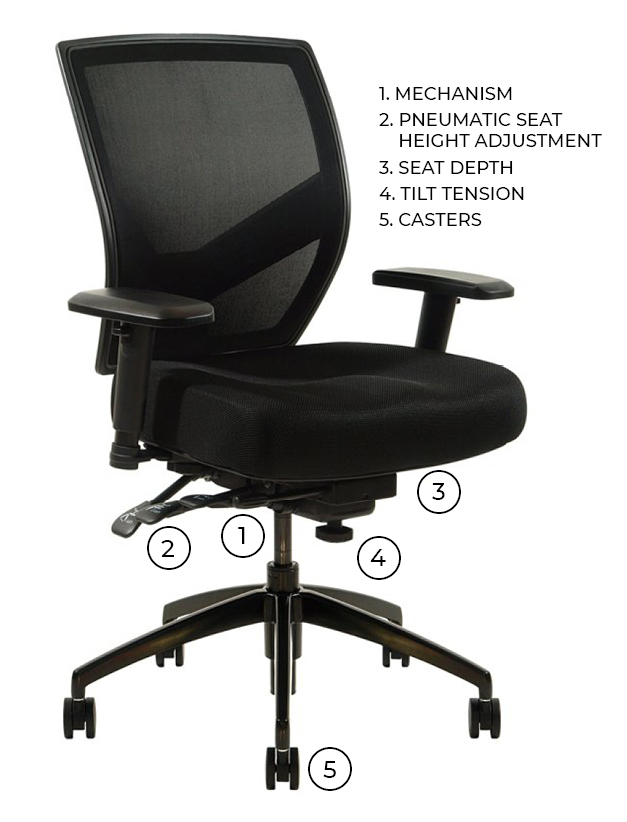We love furniture, and we love talking about it, but we realize that some of the jargon can be confusing. So, we are here to break it down, starting with chair lingo.
It’s important to us to make sure that you, the customer, are comfortable and confident when making a buying decision on new chairs. They’re a huge part of the office and getting the right fit is critical.
A great office chair is more important than you think. Most office workers spend the majority of their work day sitting. You will often hear words thrown around in reference to chairs and their features, but what do they mean?
Let’s start with ERGONOMIC. Ergonomics is defined as the science of fitting a workplace to the user’s needs. More simply, the science of making you comfortable while you work. Ergonomics aims to increase efficiency and productivity while also reducing discomfort (Humanscale).
According to a recent survey by HON on what customers are looking for in a chair, Comfort was number one according to 95% of respondents. Following closely behind are functionality (88%), lumbar support (80%) and design (76%) (HON).

So, what about LUMBAR SUPPORT? Lumbar support is all about your lower back. Generally speaking, it is anything that gives you additional support to the lumbar region. For most people, there is a natural tendency to slouch or lean forward when seated for a long period of time which pushes out the lower back turning the natural inward curve into an outward curve and causes back strain. When seated, good lumbar support should be right up against the small of your back, helping you to maintain the inward curve of your lower spine, giving you a healthy posture (Flokk).
Now let’s get to the nitty gritty, chair features. We are sure you have heard a few of these before, but what exactly do they mean?
MECHANISM – This is what enables you to make specific adjustments to the seat and backrest of the chair, like the angle of the backrest. The mechanism allows you to personalize your seat position for optimal comfort and support
 SYNCHRO MECHANISM – This is where the seat and back are synchronized to move together, so the angle between the seat and the back is always the same, this can be left to ‘free-float’ or locked at a specific angle.
SYNCHRO MECHANISM – This is where the seat and back are synchronized to move together, so the angle between the seat and the back is always the same, this can be left to ‘free-float’ or locked at a specific angle.
PNEUMATIC SEAT HEIGHT ADJUSTMENT – This makes your chair go up and down. It is recommended that your seat height should be adjusted to place your knees above or at the same level as your hips, with both feet comfortably rested flat on the ground beneath you.
SEAT DEPTH – Proper seat depth should leave between 2 and 4 inches between the edge of the seat and the back of your knees. If the seat is too far forward, it may put undue pressure at the back of the knees. Some chairs include a seat slider which allows you to adjust the seat depth to fit your body.
TILT or TILT TENSION – This is what enables you to rock or recline backward. You can lock the seat or back at your preferred angle or adjust the tilt tension which increases or decreases the amount of force needed to make the chair recline backward.
CASTERS – This one is easy. Casters are the wheels! There are two types, soft casters are made to be used on hardwood floors and hard casters are made to be used on carpet.
That was a lot of information, but we hope you now feel better acquainted with the lingo and more confident about what to look for in an office chair. If you’re ready to start your chair-finding adventure, we’re here to help! Visit our online catalog to browse our chair selection or call, chat or email us today!

Sources:
Humanscale, “What is Ergonomics?”, https://www.humanscale.com/ergonomics/what-is-ergonomics/
HON, “Must Have Chair Features”, https://www.hon.com/blog/2021/09/13/Breaking-down-the-Jargon/
Flokk, “What is lumbar support? Everything you need to know”, https://focus.flokk.com/what-is-lumbar-support-everything-you-need-to-know/








Leave A Comment